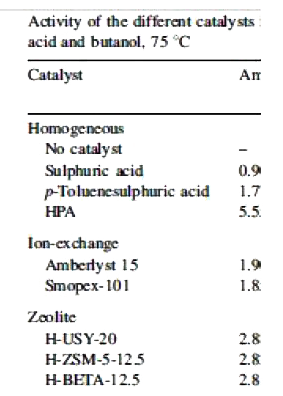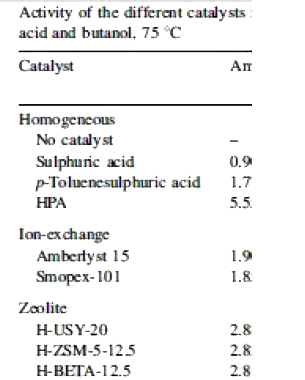Read the passage given below and answer the question:
Industrially widely applied esterification reactions are commonly catalysed using mineral liquid acids, such as sulphuric acid and p-toluenesulphonic acid. The catalytic activity of homogeneous catalysts is high. They suffer, however, from several drawbacks, such as their corrosive nature, the existence of side reactions, and the fact that the catalyst cannot be easily separated from the reaction mixture. The use of solid acid catalysts offers an alternative and has received a lot of attention in the past years. Solid acid catalysts are not corrosive and, coated onto a support, they can be easily reused. Examples of solid acid catalysts used in esterification reactions include ion-exchange resins, zeolites and superacids like sulphated zirconia and niobium acid. Ion-exchange resins are the most common heterogeneous catalysts used and have proven to be effective in liquid phase esterification and etherification reactions. Because of their selective adsorption of reactants and swelling nature, these resins not only catalyse the esterification reaction but also affect the equilibrium conversion. Shortcomings include insufficient thermal resistance, which limits the reaction temperature to 120∘C, preventing widespread use in industry. Zeolites, like Y, X, BEA, ZSM-5 and MCM 41 offer an interesting alternative and have proven to be efficient catalysts for esterification reactions. Zeolites have found wide application in oil refining, petrochemistry and in the production of fine chemicals. Their success is based on the possibility to prepare zeolites with strong Brønsted acidity that can be controlled within a certain range, combined with a good resistance to high reaction temperatures.
In this study, the activity of various commercial available solid acid catalysts is assessed with respect to the esterification of acetic acid with butanol. The ion-exchange resins Amberlyst 15 and Smopex-101, the acid zeolites H-ZSM-5, H-MOR, H-BETA and H-USY, and the solid superacids sulphated zirconia and niobium acid are selected. Comparative esterification experiments have been carried out using the homogeneous catalysts sulphuric acid, p toluenesulphuric acid and a heteropolyacid (HPA). The weight-based activity of the heterogeneous catalysts tested is maximum for Smopex 101. The following table gives the activity of different catalysts in the esterification reaction between acetic acid and butanol at 75∘C.

Here: kobs : observed reaction rate constant (m3mol−1s−1) kc catalysed reaction rate constant (m3mol−1g−1cats−1) Please note: k c = k obs/ amount (in g)
(source: PETERS, T., BENES, N., HOLMEN, A., & KEURENTJES, J. (2006). Comparison of commercial solid acid catalysts for the esterification of acetic acid with butanol. Applied Catalysis A: General, 297(2), 182-188. doi:10.1016/j.apcata.2005.09.00)
Catalysts used in oil refining industry are:
ion exchange resins
superacids
zeolites
mineral liquid acids
The correct Answer is:C
Step by step video & image solution for Read the passage given below and answer the question: Industrially widely applied esterification reactions are commonly catalysed using mineral liquid acids, such as sulphuric acid and p-toluenesulphonic acid. The catalytic activity of homogeneous catalysts is high. They suffer, however, from several drawbacks, such as their corrosive nature, the existence of side reactions, and the fact that the catalyst cannot be easily separated from the reaction mixture. The use of solid acid catalysts offers an alternative and has received a lot of attention in the past years. Solid acid catalysts are not corrosive and, coated onto a support, they can be easily reused. Examples of solid acid catalysts used in esterification reactions include ion-exchange resins, zeolites and superacids like sulphated zirconia and niobium acid. Ion-exchange resins are the most common heterogeneous catalysts used and have proven to be effective in liquid phase esterification and etherification reactions. Because of their selective adsorption of reactants and swelling nature, these resins not only catalyse the esterification reaction but also affect the equilibrium conversion. Shortcomings include insufficient thermal resistance, which limits the reaction temperature to 120^(@)C, preventing widespread use in industry. Zeolites, like Y, X, BEA, ZSM-5 and MCM 41 offer an interesting alternative and have proven to be efficient catalysts for esterification reactions. Zeolites have found wide application in oil refining, petrochemistry and in the production of fine chemicals. Their success is based on the possibility to prepare zeolites with strong Brønsted acidity that can be controlled within a certain range, combined with a good resistance to high reaction temperatures. In this study, the activity of various commercial available solid acid catalysts is assessed with respect to the esterification of acetic acid with butanol. The ion-exchange resins Amberlyst 15 and Smopex-101, the acid zeolites H-ZSM-5, H-MOR, H-BETA and H-USY, and the solid superacids sulphated zirconia and niobium acid are selected. Comparative esterification experiments have been carried out using the homogeneous catalysts sulphuric acid, p toluenesulphuric acid and a heteropolyacid (HPA). The weight-based activity of the heterogeneous catalysts tested is maximum for Smopex 101. The following table gives the activity of different catalysts in the esterification reaction between acetic acid and butanol at 75^(@)C. Here: k_(obs) : observed reaction rate constant (m^(3) mol^(-1)s^(-1)) kc catalysed reaction rate constant (m^(3)mol^(-1) g_(cat)^(-1)s^(-1)) Please note: k c = k obs/ amount (in g) (source: PETERS, T., BENES, N., HOLMEN, A., & KEURENTJES, J. (2006). Comparison of commercial solid acid catalysts for the esterification of acetic acid with butanol. Applied Catalysis A: General, 297(2), 182-188. doi:10.1016/j.apcata.2005.09.00) Catalysts used in oil refining industry are: by Chemistry experts to help you in doubts & scoring excellent marks in Class 12 exams.
Updated on:21/07/2023Topper's Solved these Questions
Similar Questions
De-icing is the process of removing snow, ice or frost from a surface. In extremely cold regions, car windows get covered by ice reducing the visibility. The image below shows the de-icing of the window of a car during extreme cold using a fluid.

Which of the following compounds could be present in the de-icing fluid used above?
View SolutionMatch the following:

Which of the following is the best matched options?
View Solutionthe catalyst used in the contact process for manufacturing of sulphuric acid is
View Solutionसल्फुरिक अम्ल के औद्योगिक निर्माण में प्रयुक्त उत्प्रेरक है-
View Solutionसल्फ्यूरिक अम्ल के औधोगिक निर्माण में प्रयुक्त उत्प्रेरक है-
View SolutionThe use of a catalyst in chemical reaction…activation energy of the reaction
View SolutionWhat catalysts are used in the industrial preparation of nitric acid?
View SolutionSulphuric acid is used in Esterification reaction because it is
View SolutionReaction of Alcohol with carboxylic acid in presence of acid catalyst is known as …….. reaction.
View SolutionName the reaction where Lewis acid is used as catalyst for aromatic alkylation.
View SolutionName the reaction where Lewis acid is used as catalyst for aromatic alkylation.
View SolutionThe catalyst used in the contact process of sulphuric acid is :
View SolutionIn the alpha-halogenation of aliphatic acid (HVZ reaction ) the catalyst used is:
View SolutionIn the alpha-halogenation of aliphatic acid (HVZ reaction ) the catalyst used is:
View Solutionhydrolysis OF ester || Acid catalysed hydrolysis || Esterification reaction
View SolutionRead the passage given below and answer the question:
Industrially widely applied esterification reactions are commonly catalysed using mineral liquid acids, such as sulphuric acid and p-toluenesulphonic acid. The catalytic activity of homogeneous catalysts is high. They suffer, however, from several drawbacks, such as their corrosive nature, the existence of side reactions, and the fact that the catalyst cannot be easily separated from the reaction mixture. The use of solid acid catalysts offers an alternative and has received a lot of attention in the past years. Solid acid catalysts are not corrosive and, coated onto a support, they can be easily reused. Examples of solid acid catalysts used in esterification reactions include ion-exchange resins, zeolites and superacids like sulphated zirconia and niobium acid. Ion-exchange resins are the most common heterogeneous catalysts used and have proven to be effective in liquid phase esterification and etherification reactions. Because of their selective adsorption of reactants and swelling nature, these resins not only catalyse the esterification reaction but also affect the equilibrium conversion. Shortcomings include insufficient thermal resistance, which limits the reaction temperature to 120∘C, preventing widespread use in industry. Zeolites, like Y, X, BEA, ZSM-5 and MCM 41 offer an interesting alternative and have proven to be efficient catalysts for esterification reactions. Zeolites have found wide application in oil refining, petrochemistry and in the production of fine chemicals. Their success is based on the possibility to prepare zeolites with strong Brønsted acidity that can be controlled within a certain range, combined with a good resistance to high reaction temperatures.
In this study, the activity of various commercial available solid acid catalysts is assessed with respect to the esterification of acetic acid with butanol. The ion-exchange resins Amberlyst 15 and Smopex-101, the acid zeolites H-ZSM-5, H-MOR, H-BETA and H-USY, and the solid superacids sulphated zirconia and niobium acid are selected. Comparative esterification experiments have been carried out using the homogeneous catalysts sulphuric acid, p toluenesulphuric acid and a heteropolyacid (HPA). The weight-based activity of the heterogeneous catalysts tested is maximum for Smopex 101. The following table gives the activity of different catalysts in the esterification reaction between acetic acid and butanol at 75∘C.

Here: kobs : observed reaction rate constant (m3mol−1s−1) kc catalysed reaction rate constant (m3mol−1g−1cats−1) Please note: k c = k obs/ amount (in g)
(source: PETERS, T., BENES, N., HOLMEN, A., & KEURENTJES, J. (2006). Comparison of commercial solid acid catalysts for the esterification of acetic acid with butanol. Applied Catalysis A: General, 297(2), 182-188. doi:10.1016/j.apcata.2005.09.00)
Which of the following are heterogeneous catalysts for esterifctaion reaction:
View Solution
